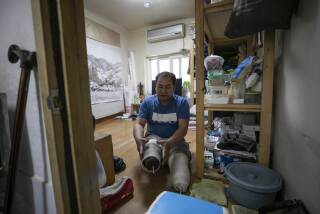Japan Disaster: A Year Later: Without a blueprint
On a cold and gray recent Sunday afternoon, a standing room crowd of more than 100 residents packed the community center of this small seaside city to observe an unusual job interview.
Five architects made presentations to a design jury, hoping for a chance to design a replacement for the local middle school, heavily damaged a year ago by the earthquake and tsunami that killed an estimated 19,000 people, including at least 58 here, and destroyed more than 120,000 buildings.
Kumiko Inui, a 42-year-old rising star of the Tokyo architecture scene, ultimately won the competition with an impressive design featuring tall glass-wrapped classroom wings paired with smaller wooden pavilions in a lush tree-covered landscape.
INTERACTIVE PHOTOS: Before and after tsunami cleanup
But an ugly reminder of the disaster loomed over the presentations: A three-story-high pile of tsunami debris, visible through large picture windows along the side of the room, that didn’t so much mock the architectural discussion as dwarf it.
As Japan nears the anniversary of the disaster this Sunday, such scenes are playing out all over northeastern Japan. Huge, neatly sorted piles of debris dot the Tohoku region, symbols of a recovery that has stalled at the cleanup stage.
Prime Minister Yoshihiko Noda, his approval rating in danger of sinking below 30%, has faced wide criticism for failing to articulate a broad vision for rebuilding. The national Reconstruction Agency wasn’t officially launched until February, 11 months after the disaster.
And though Toyo Ito, Kazuyo Sejima and other leading Japanese architects have joined emerging talents like Inui in sketching out thoughtful plans for new housing and civic architecture, their efforts have so far garnered little support from politicians in Tokyo.
The most intractable issue is whether the hardest hit fishing villages, already losing population before the disaster, should be rebuilt as they were or consolidated. In a broader sense, the nation has struggled with basic issues at the core of reconstruction, particularly the way the tsunami has exposed gaps between rich and poor, young and old, rural and urban, and between the nation’s technological haves and have-nots.
In much the same way that Hurricane Katrina and its aftermath gave Americans a discomfiting picture of their own society, the events of March 11 have laid bare a Japan more divided than the national discourse here lets on.
“The tsunami attacked our poorer communities and [has] shown us how much they were already struggling,” said Masashige Motoe, a professor in the department of architecture and building science at Tohoku University in Sendai. “No one wants to see that. No one wants to face it.”
Sendai, a coastal city of 1 million people, has become an unlikely post-disaster boom town. Though its coast was heavily damaged by the tsunami, the majority of the city stayed dry, and significantly, its political structure remained intact.
Along wide and tree-shaded Jozenji Avenue, the area around the Sendai Mediatheque — a 2001 building designed by Ito and famous among architects around the world — is bustling. A video widely circulated on the Internet, shot from underneath a table inside the Mediatheque as the earthquake raged, showed the building shaking violently. But the minor damage it suffered was repaired months ago.
Sendai’s relative good fortune has boosted its population, which had been slowly ebbing before the disaster, and given it a leg up in recovery planning. After intense negotiations with residents of its coastal neighborhood, an area along Arahama Beach that was wiped off the map by the surge, the city has decided to prohibit all construction in a half-mile-wide strip along the ocean.
It plans to turn that land into a park while fortifying its sea wall and relocating 8,500 residents to higher ground. The city is still in talks with homeowners about buying their land so they can find new property inland.
“This is a very delicate process and we want to have as much consensus of the citizens as possible,” said Jun Umenai, director of Sendai’s office of recovery projects.
In the towns and fishing villages devastated by the tsunami to the north of Sendai, that search for consensus has in many cases stymied the recovery process. In Onagawa, a town of 9,000 where steep, narrow valleys flow directly toward the sea, the damage still looks biblical: Three concrete buildings were ripped from their foundations and lie sideways in the muck.
Onagawa’s mayor, Nobutaka Azumi, settled last year on a plan to consolidate the 15 fishing villages that the city oversees, citing declining populations and dimming economic prospects there. But he was pushed out of office by older residents who aggressively opposed the idea. A new mayor has vowed to rebuild every last village.
That sharp disagreement over reconstruction goals has repeated itself in the smaller towns along the Oshika Peninsula. In early March the central government approved $3.75 billion in rebuilding grants for 59 villages and towns, part of a larger fund of $120 billion earmarked for recovery projects. (Much of that larger fund is designated for repairing roads, bridges, train lines and other infrastructure, along with paying for the temporary housing that still holds more than 300,000 displaced residents.) But the lack of consensus on basic issues calls into question precisely how the grant money will be spent.
That’s the case in Kobuchihama, one of the larger fishing villages heavily damaged by the tsunami, in part because of its unusual geography. It is connected by a narrow spit of land to an offshore peninsula, with bays facing the ocean in two directions. When then tsunami hit, a pair of surges collided above the split, sending up a massive fountain of water residents say was nearly a hundred feet high.
Architect Shoko Fukuya, a recent transplant from Tokyo, is helping lead the recovery planning on the Oshika Peninsula. On a blustery afternoon she stopped her car near Kobuchihama’s fisherman’s union building, where a group of roughly 50 local men, still unable to get the businesses they rely on up and running, were awaiting instructions from regional officials who had hired them to help with cleanup operations. She took a preliminary map of the recovery plan for the village and spread it atop the hood of the car, indicating where new housing was planned.
“We gave the local residents a questionnaire,” she said, “and 70% of them want to remain.”
But at 70% of its pre-tsunami population the village would struggle to survive economically. There is disagreement even among those wishing to stay about the course of rebuilding, she added, as a number of fishermen came over to greet her.
After speaking with them in Japanese, she gave a loose translation of their comments: “Many of the fishermen are living in temporary housing, and they say they like it just fine. They want us to concentrate on rebuilding the facilities for fishing and forget about new housing.”
The local government has set a deadline at the end of March for the villagers to settle on the location for a new residential neighborhood.
In nearby Samenoura, a town where every house within two blocks of the sea was destroyed, an early rebuilding plan called for new housing atop a hill a safe distance from the water. But residents balked, and now a new plan, still being finalized, calls for them to move to another, slightly lower hill closer to the beach.
Fukuya said the impulse to get closer to the water is understandable: “Just look at the map. The coastline and fishing are in Japan’s DNA.”
Hitoshi Abe, chairman of the architecture department at UCLA and a native of Sendai, has made seven trips to the region since last March. He played a hand in coordinating the design competitions in Shichigahama and elsewhere, under the rubric of a Sendai-based group called Archi-Aid. He also helped plan an exhibition to mark the anniversary of the disaster; it runs through April 15 at UCLA’s Fowler Museum.
“One of the major problems in this particular disaster is that the affected area is just so huge and diverse,” he said. “So if you’re only looking at the recovery plan in Sendai, it looks pretty good. But if you look at the whole of eastern Japan there are all sorts of remaining issues and obstacles.”
Added Abe, “Right now it’s atomized. It’s hard to see any larger vision.”
Still, he was optimistic about the progress being made in Shichigahama, where construction on Inui’s middle school will begin early next year, with a planned opening date of fall 2014. Another design competition in the town produced a design for a new elementary school.
And before either school design was chosen, the town had moved ahead with an impressive plan to remake its extensive beachfront, which is famous around the region. The name Shichigahama means “Seven Beaches.”
So what makes this town different? It helped that the school sites, among the highest points in hilly Shichigahama, had little flood damage and are ready to rebuild. Even more important was the fact that the local government saw ambitious new architecture as a way to promote a sense of unity and rebirth and as a result chose not to leave the rebuilding to civil engineers alone.
According to Yasuaki Onoda, an architect and professor at Tohoku University who is advising the town, Shichigahama officials “realized that a school is not just a school anymore. It also has to operate as a community evacuation center — and as a symbol of reconstruction.”
INTERACTIVE PHOTOS: Before and after tsunami cleanup
christopher.hawthorne@latimes.com
More to Read
Start your day right
Sign up for Essential California for news, features and recommendations from the L.A. Times and beyond in your inbox six days a week.
You may occasionally receive promotional content from the Los Angeles Times.







